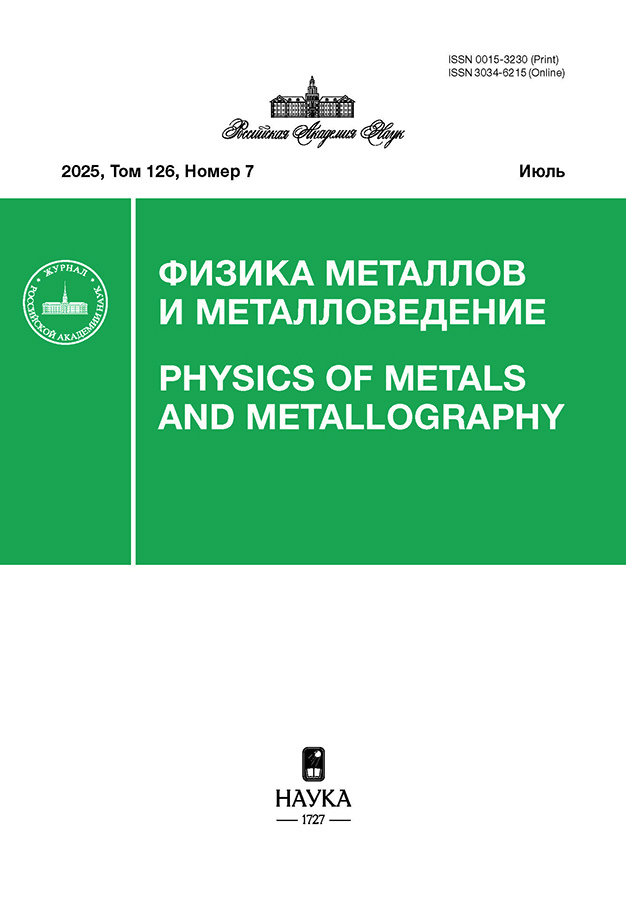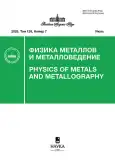Physics of Metals and Metallography
Physics of Metals and Metallography (PMM) was founded in 1955 by the USSR Academy of Sciences. The journal publishes 14 issues per year (12 issues in Russian and English and 13, 14 issues in English only).
Founders
- Russian Academy of Sciences (RAS)
- Ural Branch of Russian Academy of Sciences (UB RAS)
- M.N. Miheev Institute of Metal Physics of Ural Branch of Russian Academy of Sciences (IMP UB RAS)
PMM scope covers the wide range of metals related condensed matter physics and metal materials science, including the following rubrics.
- Magnetism, magnetic materials and spintronics (magnetic phase transitions, magnetic structures, hard and soft magnetic materials, magnetic semiconductors, magnetism in disordered systems, multiferroicity and ferroelectricity, low-dimensional magnetism, magnetism of surface and interfaces, nanomagnetism, spin transport, spin waves, spin relaxation, spin resonance, neutron magnetic scattering.);
- Electronic structure, strongly correlated systems and electron transport (many-body methods, density functional theory, Hubbard and related models, heavy fermions, topological insulators, metamaterials, metal-insulator transitions, electronic transport, galvanomagnetic phenomena, optical properties, optical and X-ray spectroscopies, superconductivity and superconducting materials);
- Surface, interface and nanoscale physics (metal surface structure, surface probes, various spectroscopies, interfaces, metal-semiconductor interface, surface electronic structure and bonding, surface dynamics, interactions on surfaces, mesoscopic systems, microstructures, layered materials, nanostructures, metallic superlattices, fullerenes, graphene, nanotubes, nanoclusters, thin films, molecular electronics, tunneling and other quantum transport phenomena);
- Structure, phase transitions and diffusion phenomena (single- and polycrystal metals materials, disordered systems, positional and compositional disorder, alloys, new phases, defect structures, structural probes and spectroscopy);
- Mechanical properties (strength, plasticity, hardness, brittleness, toughness, impact resistance, tribology, irradiation effects, coatings, high-pressure physics).
Ағымдағы шығарылым
Том 126, № 7 (2025)
ЭЛЕКТРИЧЕСКИЕ И МАГНИТНЫЕ СВОЙСТВА
FEATURES OF THE FERROMAGNETIC STATE IN A MAGNET WITH ORBITAL ORDERING
Аннотация
The features of temperature and field behavior of the ferromagnetic state in the two-spin Kugel–Chomsky model describing the relationship between the ferromagnetic spin and antiferromagnetic pseudospin orbital orderings are investigated. The case is analyzed when the critical temperature of the antiferromagnetic orbital ordering Tl is higher than the critical Curie temperature of the spin ferromagnetic order Ts. It is
shown that in this case the existence of an exchange coupling of the ferromagnetic spin subsystem with the orbitally ordered subsystem leads at finite temperatures to a decrease in both the spontaneous and induced magnetization of the ferromagnetic state compared to similar characteristics of the ferromagnetic state in a media without orbital ordering.
 747-757
747-757


RESONANCE QUANTUM EFFECTS IN THE MAGNETORESISTANCE OF Nd2–xCexCuO4/SrTiO3 EPITAXIAL FILMS
Аннотация
Magnetotranport properties of electron-doped layered superconductor Nd2–xCexCuO4 (x = 0.145) with intrinsic Josephson junctions are studied in the resistive state and in the Josephson vortex flow mode. We associate the periodic steps of magnetoresistance, Rс(B), observed in the flux-flow mode with the resonant response of the system to the magnetic field-induced change in the number of Josephson vortices, each of which contains a quantum of magnetic flux.
 758-766
758-766


FEATURES OF THE CURRENT-VOLTAGE CHARACTERISTICS OF LAYERED HIGH-TEMPERATURE SUPERCONDUCTORS
Аннотация
The paper presents the results of measurements of the current-voltage characteristics (IVC’s) in the electron-doped layered superconductor Nd2–xCexCuO4 and the results of the scaling analysis of the U(I) dependence for a large set of layered HTSC’s. It is shown that the IVC’s of hole-doped compounds indicate a monotonic behavior of the d-wave symmetry order parameter, while the IVC’s of electron-doped compounds Nd2–xCexCuO4 with x = 0.15 and Sm2–xCexCuO4 exhibit a non-monotonic nature of the d-wave symmetry order parameter associated with the coexistence of superconductivity and fluctuations of antiferromagnetic spin excitations.
 767-771
767-771


INFLUENCE OF SELECTIVE LASER MELTING PARAMETERS AND POST-PROCESSING ON MAGNETIC PROPERTIES OF RING MAGNETIC CORE CABLES MADE OF IRON POWDER
Аннотация
The work is devoted to the study of the magnetic hysteresis properties of ring-shaped magnetic cores made by selective laser melting (SLM) from iron powder. The dependence of the magnetic properties of the obtained samples on the parameters of additive manufacturing (speed and direction of the laser beam) and on subsequent heat treatment was investigated. It was found that reducing the speed of the laser beam spot movement along the build surface, selecting the direction of the laser beam spot movement along the axis perpendicular to the squeegee, and performing heat treatment leads to an increase in magnetic induction and magnetic permeability and a decrease in specific magnetic losses. This is due to the fact that during annealing, internal mechanical stresses are removed, the gradient of which hinders the movement of domain
boundaries during remagnetization. A comparison of the magnetic properties of printed samples and samples made by pressing from the same powder was carried out. It was shown that the pressed samples are inferior to the samples made by SLM in terms of magnetic induction and permeability.
 772-780
772-780


MAGNETIC ORDER IN THE SANDWICH STRUCTURE OF THE COMPOUND Fe3GeTe2
Аннотация
Magnetic ordering of the sandwich structure of the Fe3GeTe2 compound is investigated. Two cases are considered. In the first case, the interaction between the layers containing iron atoms is neglected. In the second case, such interaction is considered small. It is shown that in the first case, a phase transition to a ferromagnetic state of the Ising type with a one-component order parameter takes place in two-dimensional layers containing only iron atoms. The magnetic moment is oriented along the z axis. The assumption is used that in the Fe/Ge layer, the exchange interaction of iron atoms is indirect through germanium atoms and antiferromagnetic. Long-range magnetic order is absent in this plane, but antiferromagnetic fluctuations of the transverse spin wave type are present. When the interaction between the layers is taken into account, a long-range ferromagnetic order will appear in the system, realized on the layers containing only iron atoms. Antiferromagnetic fluctuations will coexist with ferromagnetism.
 781-787
781-787


MAGNETIC STATE OF IMPURITY IRON ATOMS IN INDIUM (III) OXIDE Fe:In2O3–δ DEPENDING ON OXYGEN CONTENT
Аннотация
Calculations in the coherent potential approximation have confirmed modern concepts of various charge, spin, and magnetic states of impurity iron atoms replacing indium atoms in (In0.95Fe0.05)2O3–δ oxide with nonstoichiometric oxygen compositions (0 < δ ≤ 0.09). The transition of impurity iron atoms from a paramagnetic to a ferromagnetic state is described. It was found that the transition occurs at different concentrations of oxygen vacancies for two crystallographically nonequivalent types of impurity iron atoms and is accompanied by a change in the charge state of the impurity.
 788-793
788-793


ANALYSIS OF TEMPERATURE TRANSFORMATION OF MAGNETIC DOMAIN STRUCTURE OF Nd2Fe14B SINGLE CRYSTAL IN THE MODEL OF FRACTAL THERMODYNAMICS
Аннотация
The fractal thermodynamics model was applied for the first time to study the process of temperature-induced transformation of the magnetic domain structure (DS) on the basal plane of an Nd2Fe14B single crystal within the temperature range of 20–285 K. This range encompasses a second-order spin-reorientation transition (SRT) from the “easy axis” type of magnetocrystalline anisotropy (MCA) to the “easy cone” type of MCA. A high degree of similarity between the patterns of the Nd2Fe14B single crystal's domain structure images and fractals was demonstrated across the entire temperature interval. Specifically, the values of the parameter δ, characterizing the relative deviation of the studied DS from fractals, fall within the range of 1.16⋅10−⁶ to 1.72⋅10−². A notable difference was observed in the character of the temperature dependencies of the fractal parameters D(T), Sf(T), and Tf(T) at temperatures below and above the SRT temperature TSRT = 135 K. Furthermore, the temperature behavior of the fundamental constants of the Nd2Fe14B compound and the fractal parameters of the DS within the “easy axis” MCA region suggests a possible correlation between them in this temperature range.
 794-802
794-802


СТРУКТУРА, ФАЗОВЫЕ ПРЕВРАЩЕНИЯ И ДИФФУЗИЯ
MACROSCOPIC DEFECTS AFTER FRICTION STIR WELDING IN THE WELD JOINT OF THE Al–Mg SYSTEM ALLOY
Аннотация
The structure and phase composition of the lap joint of aluminum alloy AMg6 obtained by friction stir welding are studied. The formation of complex macroscopic defects in the welded joint is detected. The conditions for the formation of macroscopic defects in aluminum joints obtained by friction stir welding and methods for preventing the formation of defects are discussed.
 803-816
803-816


MODELING OF THE DIFFUSION PROCESS IN A COPPER–ALUMINUM BIMATERIAL
Аннотация
The study is devoted to the numerical modeling of diffusion processes in aluminum-copper bimetals using the finite element method. The focus is on the peculiarities of interdiffusion during the heat treatment of Al–Cu bimetallic materials and on the processes of formation and growth of intermetallic compounds in the Al–Cu system under elevated temperatures. The application of a migration diffusion model made it possible to account for the influence of temperature and stress concentration on the annealing process
and on the interaction of materials and compounds under heating – an aspect unattainable with the standard diffusion model. This approach also enabled the construction of concentration distribution curves for copper and aluminum at different annealing temperatures and durations. A computational algorithm was developed for the formation and growth of intermetallic compounds in the sample, taking into account annealing temperature and the concentration of diffusing elements in accordance with the Al–Cu phase equilibrium diagram. As a result, intermetallic layers forming at the metal–metal interface during interdiffusion of copper and aluminum were obtained, which is consistent with experimental findings. It is shown that the numerical experiment demonstrates good qualitative and quantitative agreement with experimental data on
the thickness of the diffusion layer at the Al–Cu interface, with the simulated phase dimensions matching those observed experimentally within the margin of error.
 817-825
817-825


MODEL OF ANOMALOUS CARBON DIFFUSION DURING SPARK PLASMA SINTERING OF TUNGSTEN CARBIDE
Аннотация
A model to explain the causes of anomalous carbon diffusion in tungsten carbide during spark plasma sintering (SPS) of α-WC + W2C powders has been proposed. The phenomenon of anomalously deep carbon penetration into tungsten carbide ceramics during SPS of a powder billet in graphite tooling, as discovered in previous studies by the authors, is characterized by the formation of an anomalously deep layer (∼ 50 mm in thickness) of pure tungsten monocarbide (a-WC) on the ceramic surface. The formation of this layer is due to the reduction of tungsten semicarbide (W2C) during its interaction with carbon diffusing from the tooling surface. The thickness of the reduced layer (∼ 50 mm) is several orders of magnitude greater than the values that follow from calculations of the depth of carbon diffusion, based on tabulated values of the activation energy of carbon diffusion in tungsten carbide. The model is based on the assumption that to facilitate the phase transformation of W2C → α-WC, during which, due to the restructuring of the atomic crystal structure, a change in the volume of the unit cell occurs, it is necessary to ensure not only the flow of additional carbon to the surface of the W2C particles, but also the formation of additional volume, the value of which is proportional to the change in density during this phase transformation (∼ 10%). The creation of additional volume is provided by the flow of nonequilibrium vacancies from the sample surface. The concentration of such vacancies is proportional to the value of the change in density during the phase
transformation of W2C→α-WC and the volume fraction of the W2C particles, and in this case exceeds the equilibrium concentration of vacancies in tungsten carbide by several orders of magnitude. The presence of these vacancies facilitates the accelerated diffusion of carbon in tungsten carbide. The model allows for the estimation of changes in the diffusion coefficient and enables the calculation of the depth of carbon penetration into the sintered material.
 826-832
826-832


ПРОЧНОСТЬ И ПЛАСТИЧНОСТЬ
ON THE POSSIBILITY OF CREATING HEAT-RESISTANT ALUMINUM DEFORMABLE ALLOYS BASED ON THE Al–Cu–Mn–Ni SYSTEM WITHOUT THE USE OF HARDENING HEAT TREATMENT
Аннотация
The phase composition of ingots and hot-rolled sheets of alloys in the Al–Cu–Mn–Ni system, containing 6–8% Cu, 2% Mn, and up to 4% Ni (weight percent), has been analyzed. A structure for the phase diagram in the aluminum region has been proposed, which suggests that in the solid state, there are three fourphase regions that involve a solid solution based on aluminum and different intermetallic compounds. The possibility of creating heat-resistant deformable aluminum alloys, whose structure consists of an aluminum matrix with Al20Cu2Mn3 dispersoids and Al3(Cu,Ni)2 eutectic phases, has been established.
 833-842
833-842












